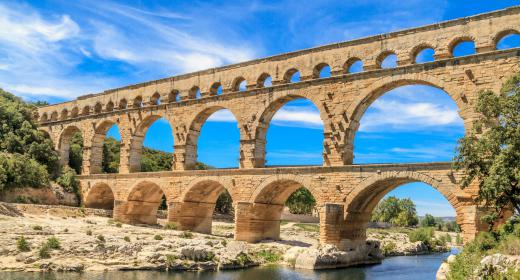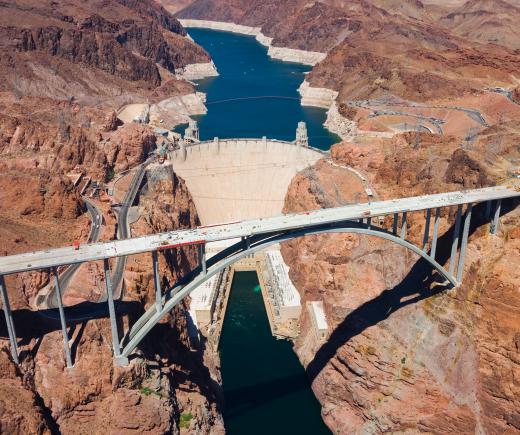What is an Arch Bridge?
An arch bridge is a type of architectural structure that relies on a curved, semi-circular shape for support. Most arches distribute weight equally and are an attractive option for bridges because they can span great distances without needing posts or other weight-bearing mechanisms to be sunk into the ground. Most post and beam bridges, by contrast, need columns or other supports placed at regular intervals. Arch bridges are common across wide rivers, gorges, and other places where it may not be practical to set up intermediary supports.
Source of Strength

The strength of this type of bridge comes from its shape. As the arch presses downward from its top, the ground pushes upward with an equal force. Extra support is also often placed along the abutments, or sides, of the structure to keep the arch from bending outwards when heavy loads press down on it, but in most cases nothing needs to touch the ground at any point along the span. As a result, the arch is always under compression, causing it to become rigid and maintain its strength.
How They’re Built

These sorts of bridges have to be built in such a way so as to handle the strong compression forces that help them keep their shape, which often takes a bit of engineering expertise. There are a couple of different techniques, but most involve starting with a basic form and then adding supports along the way. Some builders start with a wooden frame, for instance, which helps maintain the arch shape during construction. This is most common for bridges made of stone or concrete.
Once the complete arch is in place, the temporary wooden structure can be removed. Ancient stone bridges relied on the final top stone, or keystone, to be put into place for the bridge to experience the compression that would make it strong. Supports along the side of the bridge can also help keep its shape as loads press down from above.
Types of Building Material
Many of the oldest arch bridges are made of cut stone. Ancient Romans and Greeks built a number of these structures as did civilizations throughout Asia, and a number of these bridges still exist today. In some respects this may owe to the material as much as the engineering. Stones are some of the best materials for withstanding compression because of the way they absorb and transfer energy. Stone and brick are still certainly used in modern bridge construction, although steel and poured concrete, which can be more easily shaped, are also quite common.
Modern bridges that rely on reinforced poured concrete can often maintain their strength from the concrete itself, which means that no additional supports are needed along the sides. Supports are very common in metalworking, though, particularly if a bridge is designed to support great weights. Train trestles, for instance, often need to be a lot stronger than bridges used primarily by pedestrians or even passenger cars.
Variations and Uses
There are many types of arch bridges, and many different ways in which they can be used. They are perhaps most popular over water since they don’t require posts or supports to be sunk midway, which can be both disruptive to water flow and expensive to install and maintain. Depending on how high the arch is they may also allow easy passage of water vessels like boats.
It’s also common to see these bridges over steep gorges, mountain valleys, or anywhere else cars or trains need to go but where it might be difficult to sink supports. When built properly they can usually support great loads without disturbing much of the surrounding environment.
One traditional arrangement has the roadway on top of the arch, while in others, the arch rises above the roadway. In some cases they can even be built on top of each other to span a much higher elevation. This is common in the case of aqueducts, which move water from one place to another.
AS FEATURED ON:
AS FEATURED ON:












Discussion Comments
I need to know what arch bridges are specifically used for!
I think that arch bridges are just lovely! Of course, there's all of the obvious reasons why they are good -- their strength, and the fact that they allow boats to pass beneath -- but I just love how they look.
I especially love pictures of old towns in Europe that include arch bridges. It's very quaint looking.
In fact, I think that at least a third of the pictures hanging in my house are arch bridge photos. Now, if I only had the money to travel to Europe and walk across those ancient bridges!
I remember learning in school about how strong arches are and how important the keystone is.
I find it fascinating that this kind of technology was being used in ancient times. It always makes me wonder how people thought of this stuff in the first place. How did someone who was looking at a river and contemplating bridge building, just know that building an arch was the best way to go? It amazes me!
Post your comments